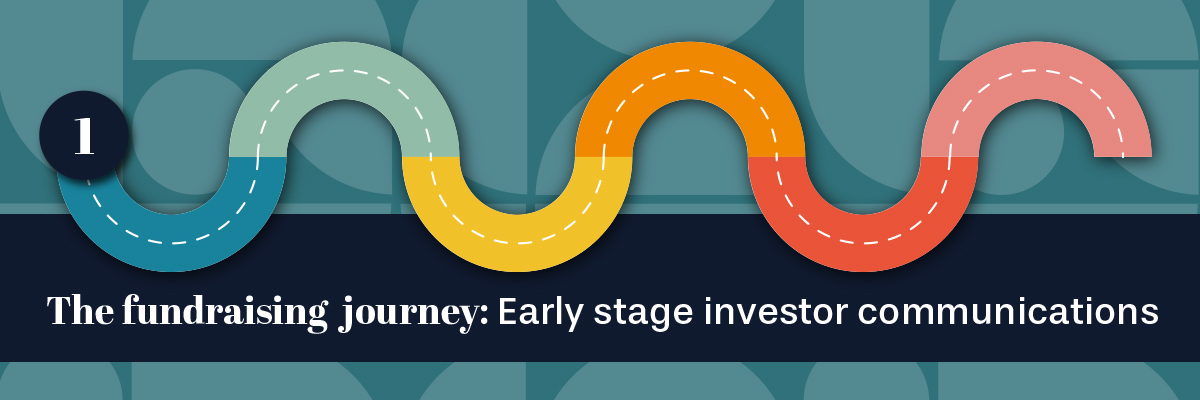The fundraising journey: Early stage investor communications
February 2023

When you’re building a business from the ground up, there’s no surefire method for all the pieces falling into place. With the right amount of planning, the right amount of luck, and the right amount of money, it’s a good bet you’ll have a successful startup on your hands. But even with the sturdiest plan, finding investors to provide you with initial capital and help your business grow can sometimes be a Herculean task.
There are many stages to the corporate journey, and the same goes for fundraising. Over the next few weeks, we’ll be publishing a series of blogs covering every stage of the fundraising journey, including early-stage funding & investor communications, pre-IPO due diligence, investor roadshows, pre-IPO research, pathfinder & final admission documents, annual reports, and ongoing shareholder & investor communications.
This week: early-stage funding and investor communications.
An introduction to startup funding
Startup funding is any sort of capital that helps to get a business up and running. There are a multitude of costs involved in starting up a company: product development, sales, manufacturing, marketing, and inventory, just to name a handful. Funding for startups tends to come in three main forms: self-funding, loans, and investors.
Pre-seed stage investor communications
The earliest stage where a startup would need to start thinking about investor communications is the pre-seed stage. You may not have a business model this early on, but you’ll have established traction for your idea.
At this stage, traction is almost as crucial as actual capital. After all, your most promising investors will be the ones who bring more than capital to the table. If they can provide you with access to new circles and networks, that could end up being a catalyst for your business’s growth. That’s two of the three main components to pre-seed investing: capital investment and access to networks. The third component would be mentoring.
Even at such an early stage, it’s important to present your company as a professional one. These days, traditional investors are more likely to take a chance on your business if you’re using a virtual data room. Most, if not all, investor communications should be taking place in a data room that allows for the secure storing, sharing, and tracking of confidential documents.
Seed stage investor communications
Next up is seed stage funding. Your business will still largely be an idea at this point, with minimal revenue if any. It’s usually only at the seed stage that startups will receive their first significant surge of investments. While you’re raising funds, you’ll be developing your product and your go-to-market strategy.
This round of funding tends to be led by specialist venture capitalists, or in some cases, angel investors. If your business is delivering on its growth targets, the investments that have been made will be gradually derisked, much to the content of your investors. In the UK, the average amount of money raised during the seed stage is roughly 2 million pounds, but this is increasing every year.
Once the seed stage is complete, there are typically three routes your business can take. The first (and, not surprisingly, the most common route) is that you’ll realise your business simply isn’t scalable enough, and has to be wound down. The second route would be realising that the capital you raised during the seed stage was enough in itself to get the business off the ground. The third and final option is moving onto three more funding rounds: Series A, Series B, and Series C.
Series A, B, and C funding
If you’ve closed your seed round of funding successfully, then around 18 months later you’ll be launching your Series A funding. The capital you’ll be dealing with will be far larger by now, and you’ll be attracting more than just specialist venture capitalists. Reaching Series A funding proves your business will likely be scalable enough to succeed, and that your investors think so too.
The Series B round of funding typically involves your company selling its equity at the settled upon valuation. There are multiple purposes to Series B funding. The investments you acquire at this stage will fund new hires, new equipment, and new business options allowing you to reach more customers. Ultimately, a successful series B round will make it a lot easier to attract bigger investments once you get to Series C.
If you’re eager to grow your business on a global level, Series C funding is the way to go about it. This is particularly popular for startups who support a public offering, or are entertaining the idea of acquisition. Funding at this point would be considered a late stage investment.
Eager to learn more about the fundraising journey and investor communications? Keep an eye out for our next blog on pre-IPO due diligence.


